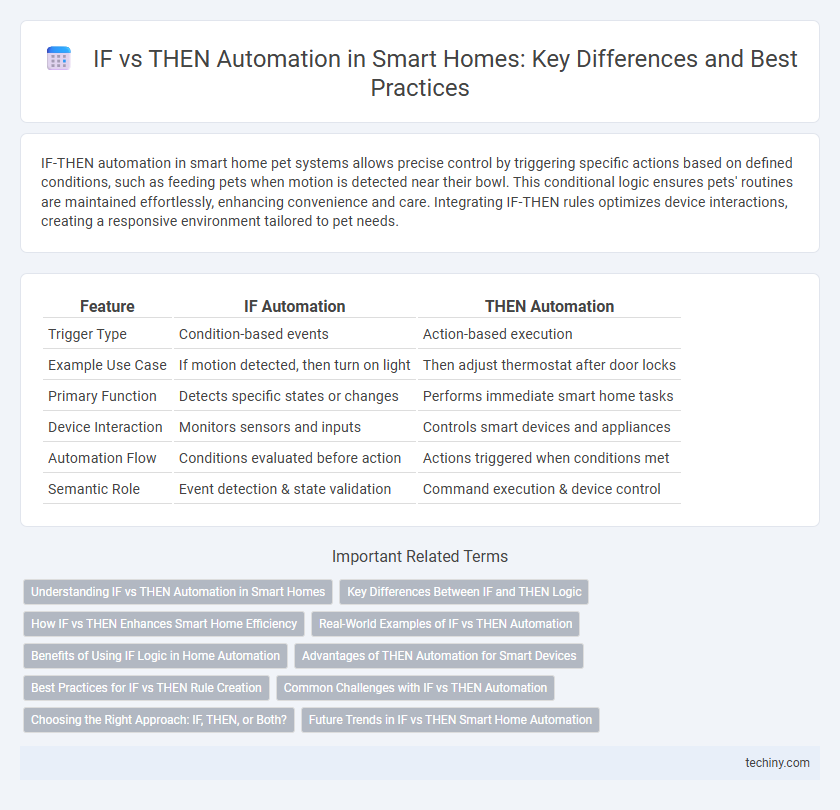IF-THEN automation in smart home pet systems allows precise control by triggering specific actions based on defined conditions, such as feeding pets when motion is detected near their bowl. This conditional logic ensures pets' routines are maintained effortlessly, enhancing convenience and care. Integrating IF-THEN rules optimizes device interactions, creating a responsive environment tailored to pet needs.
Table of Comparison
| Feature | IF Automation | THEN Automation |
|---|---|---|
| Trigger Type | Condition-based events | Action-based execution |
| Example Use Case | If motion detected, then turn on light | Then adjust thermostat after door locks |
| Primary Function | Detects specific states or changes | Performs immediate smart home tasks |
| Device Interaction | Monitors sensors and inputs | Controls smart devices and appliances |
| Automation Flow | Conditions evaluated before action | Actions triggered when conditions met |
| Semantic Role | Event detection & state validation | Command execution & device control |
Understanding IF vs THEN Automation in Smart Homes
IF automation in smart homes triggers specific actions when predefined conditions or events occur, such as turning on lights when motion is detected. THEN automation defines the resulting tasks or commands executed after the IF condition is met, like adjusting the thermostat or sending notifications. Understanding the distinction between IF (conditions) and THEN (actions) enables efficient customization of smart home routines for enhanced convenience and energy savings.
Key Differences Between IF and THEN Logic
IF logic in smart home automation triggers actions based on specific conditions or events, such as motion detected or a door opening. THEN logic defines the resulting actions that occur after the condition is met, like turning on lights or adjusting the thermostat. The key difference lies in IF serving as the conditional trigger, while THEN specifies the automated response within the smart home ecosystem.
How IF vs THEN Enhances Smart Home Efficiency
IF conditions trigger specific actions when predefined criteria are met, enabling precise control over smart home devices based on real-time data such as motion detection or temperature changes. THEN actions execute subsequent tasks that optimize energy usage and convenience, like adjusting lighting or thermostat settings automatically after IF conditions are satisfied. This IF vs THEN automation framework enhances smart home efficiency by creating dynamic, context-aware responses that reduce manual interventions and improve overall system responsiveness.
Real-World Examples of IF vs THEN Automation
IF automation triggers actions based on specific conditions, such as turning on lights when motion is detected in a room; THEN automation follows a sequence of actions, like activating the thermostat after the security system is armed. In smart homes, an IF scenario might involve closing blinds automatically when sunlight reaches a certain intensity, while a THEN example could be sending a notification to the homeowner after the front door is unlocked. These distinctions optimize energy efficiency and security by tailoring automated responses to real-time environmental changes and user behaviors.
Benefits of Using IF Logic in Home Automation
IF logic in smart home automation enables precise control by triggering actions only when specific conditions are met, enhancing efficiency and reducing unnecessary energy consumption. This conditional approach allows for personalized routines, such as adjusting lighting or temperature based on occupancy or time of day, improving comfort and convenience. Utilizing IF logic also increases system reliability by preventing conflicting commands and optimizing device interactions within the smart ecosystem.
Advantages of THEN Automation for Smart Devices
THEN automation in smart devices offers precise control by triggering specific actions when predefined conditions are met, enhancing efficiency and user convenience. This approach minimizes manual intervention, enabling seamless integration of multiple devices to work in harmony. Advantages include improved energy management, enhanced security, and personalized experiences tailored to users' habits and preferences.
Best Practices for IF vs THEN Rule Creation
Effective IF vs THEN rule creation in smart home automation hinges on clear condition-action separation, where IF clauses specify precise triggers like motion detection or time schedules, and THEN clauses define targeted actions such as adjusting lighting or temperature. Best practices emphasize minimizing overlapping triggers to avoid conflicts, leveraging sensor data accuracy, and prioritizing rules to ensure seamless execution. Regular testing and incremental updates of IF-THEN rules optimize responsiveness and energy efficiency throughout the smart home ecosystem.
Common Challenges with IF vs THEN Automation
IF vs THEN automation in smart homes often faces challenges such as delayed response times and conflicting commands that disrupt seamless device coordination. Complex scenarios with multiple IF conditions can lead to system overloads or unintended triggers, compromising reliability. Users frequently struggle with limited customization options, causing difficulty in tailoring automation workflows to specific needs.
Choosing the Right Approach: IF, THEN, or Both?
Choosing the right approach in smart home automation depends on the desired complexity and responsiveness; IF statements trigger actions based on specific conditions, while THEN statements define the resulting actions. Combining IF and THEN logic enables more dynamic and precise control, allowing devices to react intelligently to multiple scenarios. Evaluating automation goals and device compatibility ensures optimal performance and seamless integration within the smart home ecosystem.
Future Trends in IF vs THEN Smart Home Automation
Future trends in IF vs THEN smart home automation emphasize increased integration of AI-driven predictive analytics to enhance decision-making and user personalization. IF conditions will evolve beyond simple triggers to include context-aware, multi-variable inputs, enabling THEN actions to execute more adaptive and anticipatory responses. The rise of edge computing will reduce latency, allowing real-time automation adjustments that improve efficiency and seamless user experiences in smart home ecosystems.
IF vs THEN Automation Infographic

 techiny.com
techiny.com